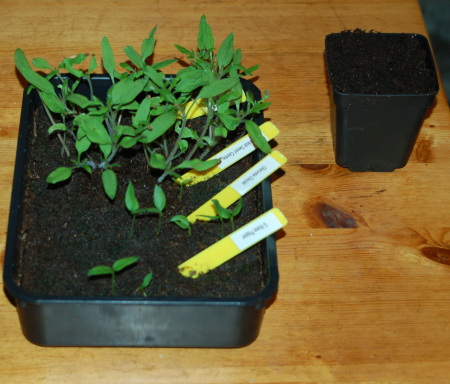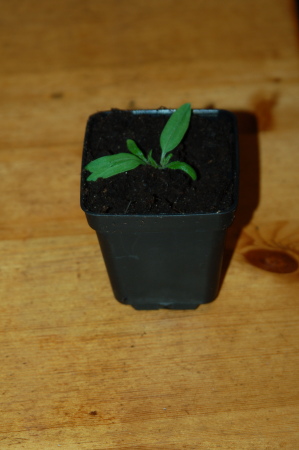
This is the same seed tray from my post of a few days ago.
The peppers in front are not quite ready, but the tomatoes in the back have started to form their first set of true leaves and so are ready for transplant. Next to the the tray is one of my standard transplanting containers full of ordinary potting soil.
After gently prying out what I think is one of the best tomato seedlings from the tray with an ordinary table knife, this is what it looks like next to the pot.

Notice the roots are very small and underdeveloped. The seedling itself is also nearly the same height as the container.
This container is about the right size to make a hole all the way down to the bottom with something like a pencil or chopstick, then insert the seedling into the hole gently with your finger. In this case, planting to the depth of the cotyledons is good. Then it looks like this:

Tomatoes have the ability to grow roots from any part of the plant that is buried. By transplanting it unusually deep like this, it helps the plant which would otherwise have a very weak root system develop a much stronger one. Tomatoes will actually benefit from having this done a number of times, but twice is a reasonable number. I’ll do it a second time when I transplant it out a final time into the garden.
If you have a problem with the seedling being spindly and fragile when doing this, it probably hasn’t been getting enough light. With a healthy seedling this is very easy to do.


What about peppers? Is it a good idea to plant them deeply as well?
This is very informative, thank you.
Hi Christina: No, only tomatoes. It’s fine to start peppers or other plants in a tray, but when you transplant them you should keep them at about the same level in the soil. I should have made this clearer in the post, thanks for bringing it up.
I can’t believe how good they look after only 10 days. Must be something in the air in Amsterdam!Have they been heated? I use a soil-blocker when I sow seeds and that way you don’t get the transplant shock and don’t have to spend ages pricking out tiny seedlings.Each seed is sown into a 2″ by 2″ by 1″ cube of soil which has been compressed enough to make it hold together. Have you ever seen one or tried it? I have written about on my blog and I find it works really well.They are quite expensive but we have one between a group of us.
Hi Kate:
Yes, they were heated. They were also grown under a sodium vapor growlight, something more common here I guess because of the marijuana growers and lots of commercial greenhouses with tomatoes and other veggies. Anyhow, that meant the seedlings got plenty of light.
A growlight like this is handy because it produces nearly twice the light per watt of electricity than fluorescent tubes and the initial costs are much lower than the equivalent number of fluorescent bulbs, fixtures and so on. It costs about US$100 new, and available for much less second hand.
It’s very light weight so I can hang it from the ceiling with a few pieces of string or plant tie wire, and I can just spread out the seedlings on the floor of any convenient room. When I’m finished using it, it’s small enough to be tucked away on a closet shelf or in a small cardboard box. This is really important for me, as I don’t really have the space for a traditional fluorescent light grow rack or table arrangement.
The disadvantage is that it is 400w, which makes it a lot more economical for a room full of plants than a single tray of seedlings, and it is bright enough I have to be careful not to bother the neighbors with it. Given where I live, it’s my best option, but I can imagine it’s not for everyone.
As far as I know, I’m the only garden blogger with a sodium vapor growlight.
Several US bloggers have been talking about soil blockers, and they too were pretty happy with them. Maybe if I can find some other interested gardeners, we’ll team up and buy one together. It seems like a good idea. I doubt they sell them here in the Netherlands, so we might have to pay the extra costs of importing it, making it even more expensive.
Thanks! I’ve learnt a very useful bit of information regarding tomatoes’ ability to grow roots. Amazing.
Hi Patrick,
Interesting post. I too have transplanted tomatoes (San Marzano) this week and have buried then deep (your suggestion thanks).
The Copia, Mortgage Lifter and Black Prince however are spindly – I’ll sow some more and see if I can get them more light!
how many days after pricking out, should tomatoes be transplanted?
Hi Niel —
About 4-6 weeks.
I usually sow the seeds indoors about 6-8 weeks before setting out.